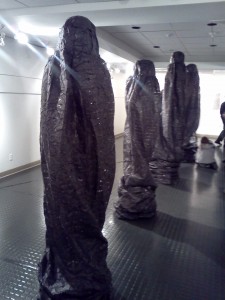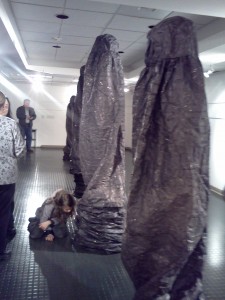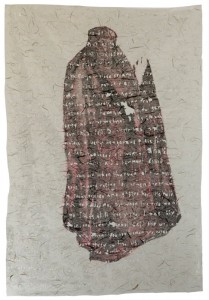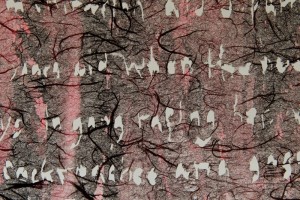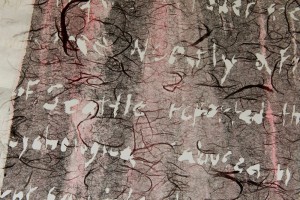Tatiana Garmendia Takes on Topic of Violence Against Women in “Veils of Ignorance”
As we were standing in the opening of the exhibition “Veils of Ignorance”, just days after a young woman had died as the victim of gang rape in India, and that country was experiencing a nationwide protest, Tatiana Garmendia stated “this exhibition could have opened any day, and there would have been an example of rape, domestic violence, or abuse of women.”
Garmendia spent many months researching domestic violence. She collected statistics from all over the world as well as narratives and poetry. The cumulative effect is overwhelming, but it is essential that we all experience this show. It is so easy to be in denial about the reality of the conditions of women today. So many artists avoid these realities in their work. Garmendia has faced them.
Her motivation is based on a childhood experience she had in Cuba
“When my nuclear family was punished by Castro’s government and sent to La Trampa, a camp for political dissidents, I witnessed acts of unspeakable violence. Most of my memories of that time are blocked, but one memory has always remained. At the age of six I was forced to watch as Marilyn, an eight year old girl, was gang raped, had her mouth and panties stuffed with cockroaches and threatened with death if she ever told. Marilyn never spoke again. Not one word.”
Bravely, Tatiana Garmendia has both shared this traumatic experience and created a deeply affecting exhibition that calls our attention to the situation of abuse for women and girls locally and globally.
Towering figures wrapped in black (they are actually about 16 feet tall, but are shortened because of the gallery ceiling height.) Their coverings which intentionally evoke the intense coverings of the most conservative Muslim women only even more so, as there is no face showing at all, are pierced by words that have been burned into the paper. Her reasoning behind referring to these “Unryu burqas “ is that it becomes a surrogate for battered women everywhere. As the artist states “I came across a statement by an Islamic feminist, ‘All women everywhere wear the burqa.’ I understood this to mean that the veil is but an outward symbol of a much more pervasive reality of oppression, one that is global and not just regional.”
Some covered women might disagree with that idea as they might have covered themselves out of piety or modesty, but the general idea of covering women comes out of a conservative rural interpretation of the threat that women pose to men (actually, it was a Byzantine tradition before it was taken up by Muslims later, in Mohammed’s time women were not covered in this way). In fact, as this exhibition makes absolutely clear, the threat is much more of men toward women.
The words the artist has burned into the paper veils and the ” flags” at the end of the gallery as well, are testimonials by women who are victims of domestic violence. The artist told me that she burned them into the paper in response to her horror that women actually burned themselves to death in order to get out of impossible domestic situations. The burned words are personal stories.
The second component of the exhibition is an audio tape which recites first hand stories and poems, alternating with worldwide statistics on the huge rates of violent attacks on women and girls. These attacks include domestic violence, trafficking, prostitution, dowry deaths, women in the military, rape and sex selected abortions and more.
The cumulative effect is overwhelming. It is enraging. The numbers are unbelievable from around the world. For example
3 women a day are murdered by husbands and boyfriends
Every 15 seconds a woman is beaten
Around the world, 1 in 3 women is beaten, coerced into sex or otherwise abused by a member of her own family
Every 9 seconds a woman is raped
In 2012 in India a dowry death occurred every 90 minutes
50,000 women are trafficked each year
2 million children forced into prostitution every year
But the installation also includes resistance:
Beware
out of the ash I rise with my red hair
and I eat men like air
And it ends on a note of hope
“We embody the power of courage, endurance of strength
the beauty of survival”
I could not help but think of the SHARE/WHEEL women who wrote the poetry in the anthology Beloved Community The Sisterhood of Homeless Women in Community. Their stories and poetry are often of a life that begins in domestic violence, but these women have survived, they are living examples of the strength of women to overcome the nightmare of personal intimate violence.
Another Seattle production was the Yoni Ki Baat monologues by South Asian Women many of which spoke of early violence in their lives.
API Chaya is an organization that helps specifically South Asian Women. It “seeks to end systematic violence in our community.”
And of course there are many more connections that could be made locally.
By the way apparently the men who raped the woman who died in India blamed the victim. See the link at start of post.
Exhibition Info: M. Rosetta Hunter Gallery ( Seattle Central Community College) until January 31. Hours 9:30 – 3:30 Mon to Fri 5-7PM Wed and Thurs evenings Phone 206 934 4379
This entry was posted on January 11, 2013 and is filed under CARA, Chaya, Seattle Art, violence against women, Women Artists.

